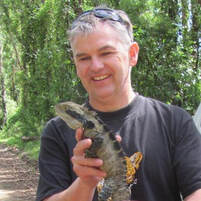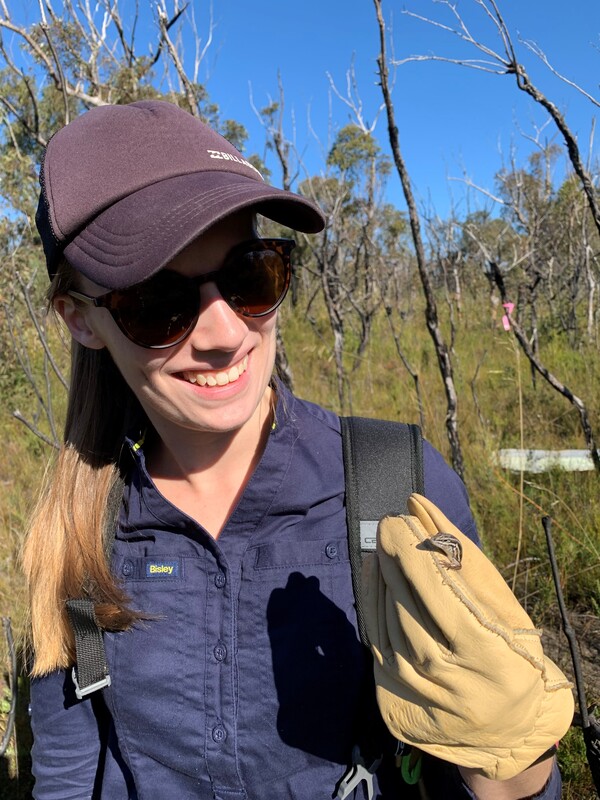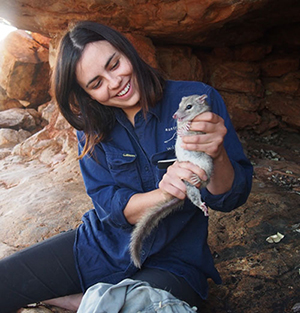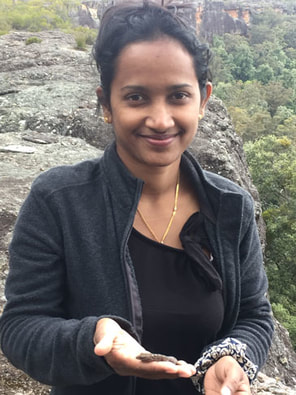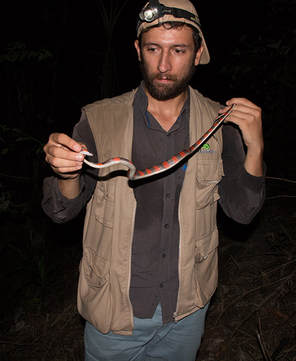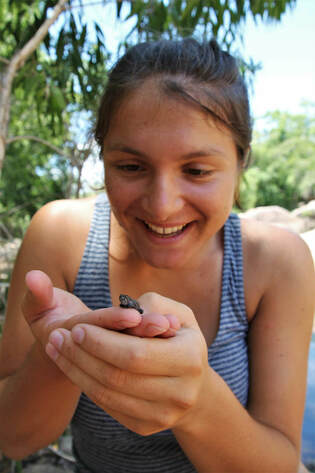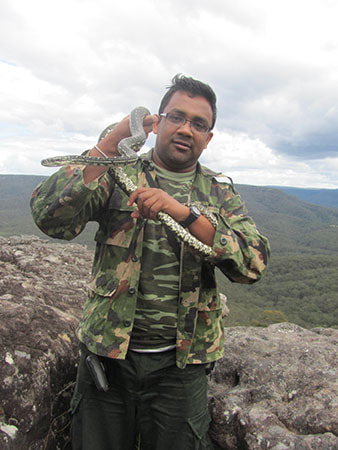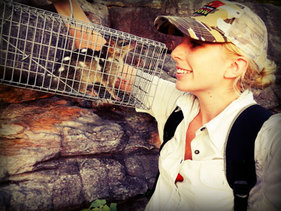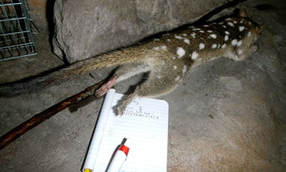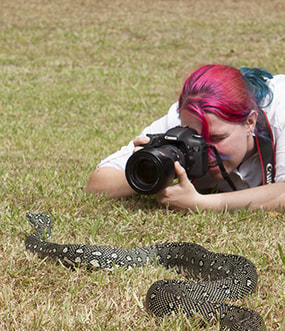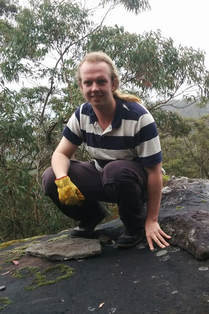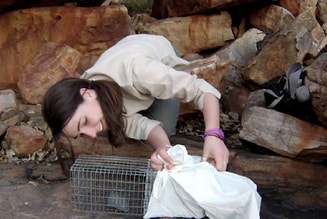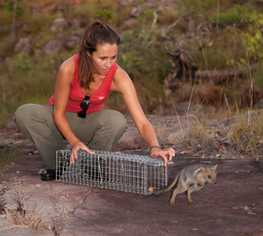Professor Jonathan Webb
|
Jonathan has broad research interests in wildlife ecology, conservation biology, behavioural ecology, and invasive species. His recent research has focused on understanding the impacts of invasive cane toads on wildlife in northern Australia, and developing novel solutions to reduce toad impacts. His research has involved a combination of laboratory experiments and longer-term field projects, in collaboration with Dr Tim Jessop, Professor Tim Dempster (Melbourne University), Professor Mike Letnic (University of NSW), and others. He is also interested in chemical communication, dispersal, and mating systems in snakes, and the evolution and maintenance of anti-predator behaviour in lizards. This latter research has involved collaborations with Professor Martin Whiting (Macquarie University) and Professor Scott Keogh (Australian National University). Jonathan is passionate about conserving wildlife, and his research aims to develop practical solutions to migitigate threatening processes. If you want to know more about the research that Jonathan's group does, please visit the Publications page. If you'd like to join our group as a volunteer, intern, or Honours or PhD student, please email Jonathan. |
Current students
|
Maddison Archer, Honours student
Maddison is investigating the medium-term impacts of the 2019-2020 megafires on reptiles. The fires caused immediate impacts on a population of endangered broad-headed snakes, but we know very little about how the fires affected populations of other rock-dwelling and woodland reptiles. In particular, we know nothing about the medium-term responses of reptiles to the megafires. To answer this question, Maddy is carrying out surveys for reptiles in study plots in high-intensity and low-intensity burnt sites, and unburnt sites. By carrying out repeat surveys, Maddy will examine whether fire intensity influences the occupancy of reptiles. |
Hall of fame
|
Dr Yingyod Lapwong, PhD completed 2021
Yingyod studied the behavior of the invasive Asian House Gecko (Hemidactylus frenatus), one of the world’s most successful invaders. This species has been found on all continents, except for Antarctica. Asian house geckos can disrupt ecosystems by competing with native species, acting as a vector for parasites and diseases, and interfering with food webs. In addition, the geckos can become a nuisance to households, as they often attain high densities in urban areas. However, the factors that have helped this species become so successful are largely unknown. To shed light on this question, Yingyod studied the behavior of Asian house geckos in their native range, and in invaded areas outside of their native range, to see whether there has been selection for particular behavioral traits in newly invaded areas. After submitting his PhD thesis, Yingyod worked as a research assistant to study the effects of the 2019-2020 bushfires on reptile populations in southeastern Australia. Yingyod is now a Lecturer at the Prince of Songkla University in Thailand. |
|
Dr Naomi Indigo, PhD, completed 2020
Naomi undertook an extremely ambitious project working with the Australian Wildlife Conservancy at Mornington Wildlife Sanctuary that aimed to prevent northern quoll populations from going extinct. To do this, Naomi developed a toad-aversion sausage that she aerially deployed ahead of the toad invasion front to train wild quolls not to eat cane toads. Naomi was fortunate to be able to work in some amazing country, though it was a logistically challenging place to work as summer temperatures regularly top 46° C! Naomi's results have been promising, and she found that a high proportion of wild quolls will consume toad-aversion sausages. However, she also found that the timing of bait delivery was crucial for training wild quolls to become toad-averse. Naomi remains optimistic that this novel technique will help to conserve one of our most iconic predators in the face of the invasion of toxic cane toads. You can read about her research findings here. |
|
Dr Theja Hemamali, PhD, completed 2019 Theja investigated how egg laying reptiles can adapt to rapidly warming climates. Currently, we do not know how climate warming will affect rock dwelling reptiles in south eastern Australia. Theja used a combination of laboratory and field experiments to determine how developmental temperatures will affect the behaviour and morphology of hatchling lizards. In the laboratory, Theja quantified how incubation temperatures affected offspring learning ability and locomotor performance. In the field, Theja used mark-recapture techniques to determine which offspring traits are subject to natural selection in the wild. Her research answered some fundamental questions in evolutionary ecology, and also increased our understanding of how climate warming may influence the persistence of rock-dwelling reptiles in south-eastern Australia. You can read more about Theja's research here. After completing her PhD, Theja took up the position of Senior Lecturer, Faculty of Applied Sciences, Rajarata University of Sri Lanka. Santiago Cuartas, MSc, completed 2019
Santiago studied the thermal ecology of nest site selection in lizards. The objectives of his project were to understand the cues that females use when selecting nest sites, and to measure geographic variation in nest temperatures across species ranges. Santiago used this information to model the effects of climate change on nest temperatures in order to understand how species may be affected by climate change and habitat fragmentation in future. His research involved lots of hiking in remote national parks and a lot of crawling and searching inside crevices for communal egg laying sites. By measuring nest site variation across broad geographic distances, Santiago helped to elucidate how gecko populations may respond to latitudinal and temporal shifts in climate. After he completed his MSc, Santiago took up a position with AMBS Ecology and Heritage. Hélène Defendini, internship student 2018, Agrocampus Ouest, France
Hélène spent six months doing an internship in our lab. For her project, Hélène investigated whether photo identification methods could be used to accurately identify individuals of the velvet gecko Amalosia lesueurii. This technique is less invasive than traditional toe-clipping, and could provide an alternative method for identifying geckos. In the field, Hélène photographed the geckos’ dorsal surface and eyes, and she then processed the pictures using the software I3S Interactive Individual Identification System. By comparing iris and dorsal pattern photos, Helene was able to evaluate which photographs were most accurate for identifying individuals. She also created a photographic database for velvet geckos that will be used to estimate some demographic parameters from analysis of mark-recapture data. |
|
Dr. Buddhi Dayananda, PhD, completed 2016 Buddhi studied how climate warming will affect populations of the velvet gecko, Amalosia lesueurii. Prior to Buddhi's research, we did not know how warming would affect gecko populations in south-eastern Australia. Buddhi used a combination of modelling, laboratory experiments, and field mark-recapture studies to determine how increases in temperature are likely to affect populations of rock-dwelling reptiles. Buddhi found that nest temperatures are likely to increase under climate warming, and such increases will produce smaller offspring, with poor cognitive abilities, and these hatchlings are less likely to survive their first year in the wild. Buddhi's research has been published in Global Change Biology and Biology Letters. Buddhi is currently working as an academic at the University of Queensland. |
|
Dr. Teigan Cremona, PhD, completed 2015
Teigan investigated whether conditioned taste aversion could reduce the impacts of cane toads on northern quolls Dasyurus hallucatus. Northern quolls were once widespread across northern Australia, but populations crashed after the arrival of toxic cane toads. Quolls can't tolerate toad toxins, and they die after attacking or mouthing large toads. We developed a novel solution to this problem, which involved feeding quolls a small dead toad coated with a nausea inducing chemical. These 'toad smart' quolls became ill, but subsequently refused to attack live toads. In 2010 we reintroduced these ‘toad smart’ quolls to Kakadu National Park. Teigan showed that some ‘toad smart’ females survived long-term and reproduced, and their offspring also survived.By radio-tracking juvenile quolls, Teigan discovered that independent juveniles forage with their mothers at night, suggesting that social learning might be involved in the acquisition of toad avoidance. Teigan's work was published in Animal Conservation and Conservation Genetics. Teigan is currently a postdoctoral research fellow at Charles Darwin University. |
|
Reannan Honey, Honours Student, 2016
Reannan studied the effects of incubation temperatures on the morphology, performance, and survival of velvet geckos. Reannan was particularly interested in the role of developmental temperatures in shaping the cognitive abilities of baby lizards. To investigate how incubation temperatures influence cognition, Reannan used a Y maze apparatus to measure how quickly lizards could remember the location of 'safe' shelters during an attack by a simulated predator. Reannan was awarded a first-class Honours for her research. She then commenced an MSc to investigate if artificial hollows are a better alternative than nest boxes for conserving wildlife. |
|
Scott Penfold, Honours Student, 2016
Scott investigated competitive interactions between spiders, ants, lizards and snakes on rock outcrops in the Sydney region. Scott explored whether native ants could exclude target species from using restored habitats. He discovered that the artificial rocks used to restore degraded rock outcrops are also very attractive to ants of the genera Campanotus, Polyrachis and Iridomyrmex, which construct large nests under rocks. These aggressive ants prevented other rock-dwelling animals, such as velvet geckos, flat rock spiders, and even snakes – from using the artificial rocks. Most worrying, Scott found that ant domination of artificial rocks has increased steadily over time, leaving fewer vacant rocks for target animals (geckos and snakes). Thus, future rock restoration projects should consider designing artificial rocks that are attractive to reptiles, but less attractive to ants. |
|
Caitlin Austin, Honours Student, 2014
Caitlin is particularly interested in conservation biology and the use of non-invasive methods to monitor Australia’s wildlife. Caitlin did her honours project at Mornington Wildlife Sanctuary, in the Kimberly, WA, in collaboration with Dr Katherine Tuft from the Australian Wildlife Conservancy. Caitlin developed a robust methodology for estimating population size of northern quolls using camera traps. Caitlin was awarded First Class Honours for her research, and she published her paper in Australian Mammalogy. |
|
Sarah Gray, Honours Student, 2014
Sarah investigated whether increases in nest temperatures affect the behaviour of velvet geckos, a nocturnal crevice-nesting species that is potentially at risk from climate change. Sarah incubated eggs at cycling temperatures to mimic current and future nest temperatures, and then released her hatchlings in the field. Sarah discovered that incubation temperatures not only affect offspring size, shape, and running speed, but also have significant effects on the lizards' short-term survival. Sarah was awarded a First Class Honours for her research, and her paper was published in Global Change Biology. |
|
Libby Dwyer, Honours Student, 2013
Libby investigated how fire regimes affect small mammal assemblages in Yengo National Park. Libby chose some very rough terrain for her field project, and she spent long hours Elliot trapping small mammals in patches with different fire histories. Libby found strong effects of fire on two species of Antechinus, suggesting that fire frequency influences mammal assemblages in south-eastern Australia. Libby has excellent field and managerial skills, and after graduating she worked as a manager for Kleinfelder Australia before moving to Canada to take up a position with Hydro One. |
|
|
